| A
Norwegian Cruising Experience Ralph Roberts, Wilhelm Munthe-Kaas and Blunderbus (W1309) explore some islands off the coast of Norway just south of the Arctic Circle in mid-July 2002 Part 1 of a log by Ralph Roberts .. |
Casually
looking up from the airport coach as it stopped to let off some
passengers on
the outskirts of 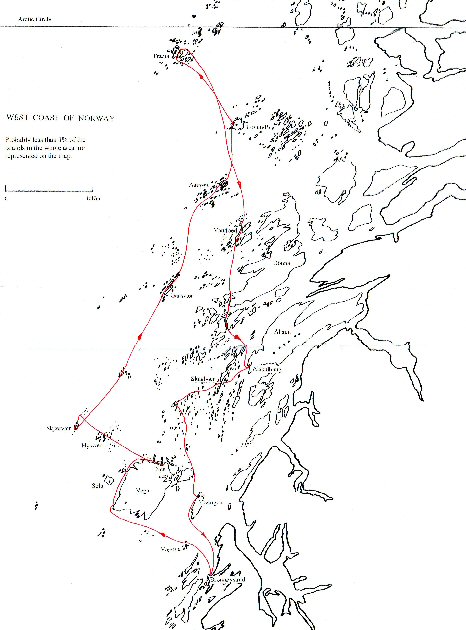 I had met
Wilhelm the previous summer at his holiday ‘hytte’ (cabin) on the
shoreline of
one of the many islands near Kragerø. He had mentioned that it
was his ambition
to cruise ‘Blunderbus’ – the Wayfarer he had bought from the renowned
UK
cruisers, Roger and Diane Aps – along the west coast of Norway, just
below the
Arctic Circle (see cruise overview above,
or click here for the
full-size version). It was an area he had briefly
visited on a cruise to
Wilhelm
had been impressed with the Harken jib furling system I had on my boat
when he
had visited me in the Spring, and I had brought along the same system
for Blunderbus. As it was a
very long drive to our destination, however, Wilhelm
had decided not to spend time fitting this on the boat before our
departure,
and we headed straight off to Brønnøysund from the coach
terminus. Wilhelm was
determined not to waste any time in getting our
Norwegian cruise started.
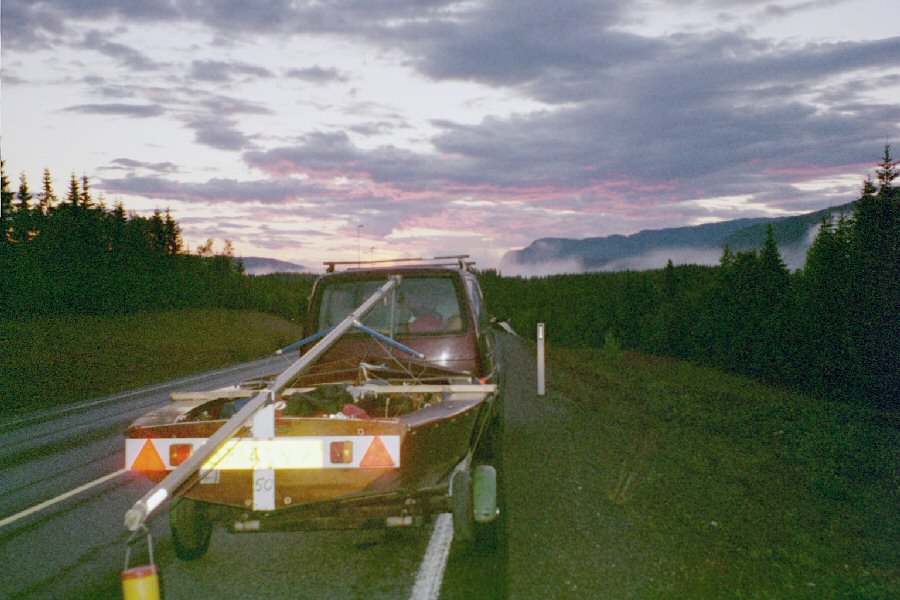 On the road beyond
Trondheim around 30 minutes past midnight, with the sun
about to dip below horizon
...and the mist from the valley we are about to descend into, just showing above the tree line. |
|
Day 1:
Brønnøysund to Vagøya
We
didn’t reach Brønnøysund until late in the afternoon,
where we first stocked up
with food from the local supermarket before finding the marina to
launch the
boat.
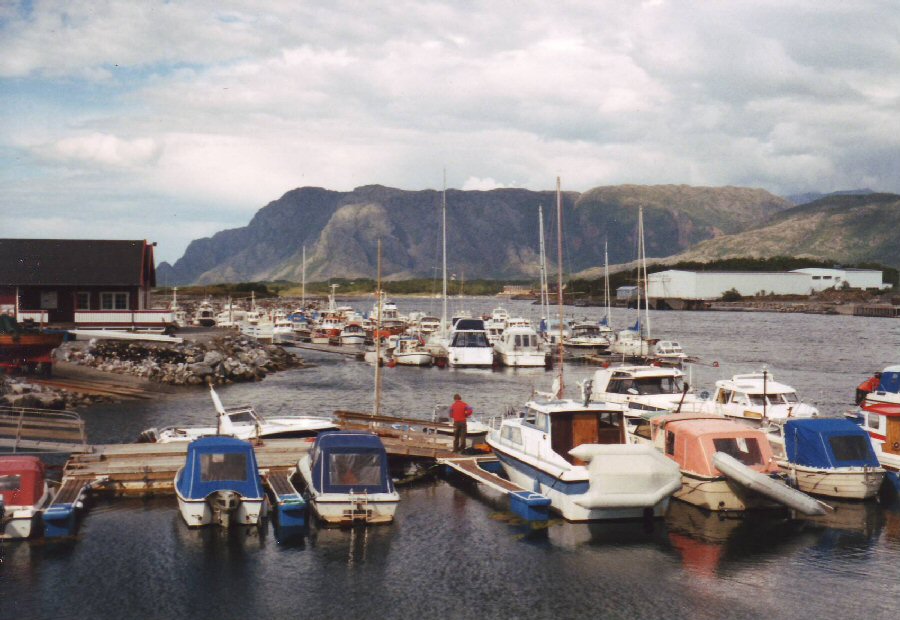 Wilhelm (red
jacket) prepares to load all
the
gear for our two-week trip after
launching Blunderbus at the
The view is looking north into the direction we are about to sail. 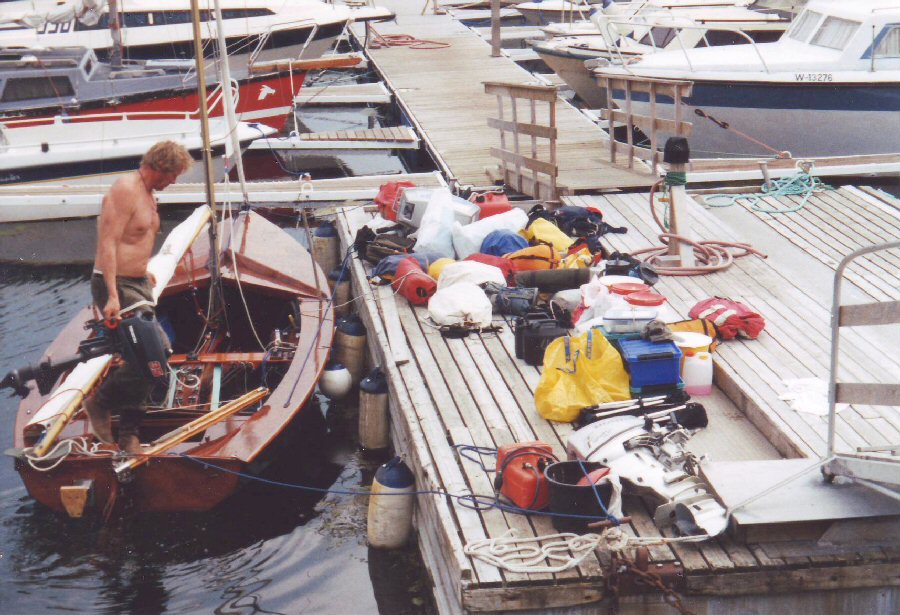 Wilhelm holding the
outboard - all other
items of gear used on the trip are laid out on the pontoon.
(Picture taken after our return). 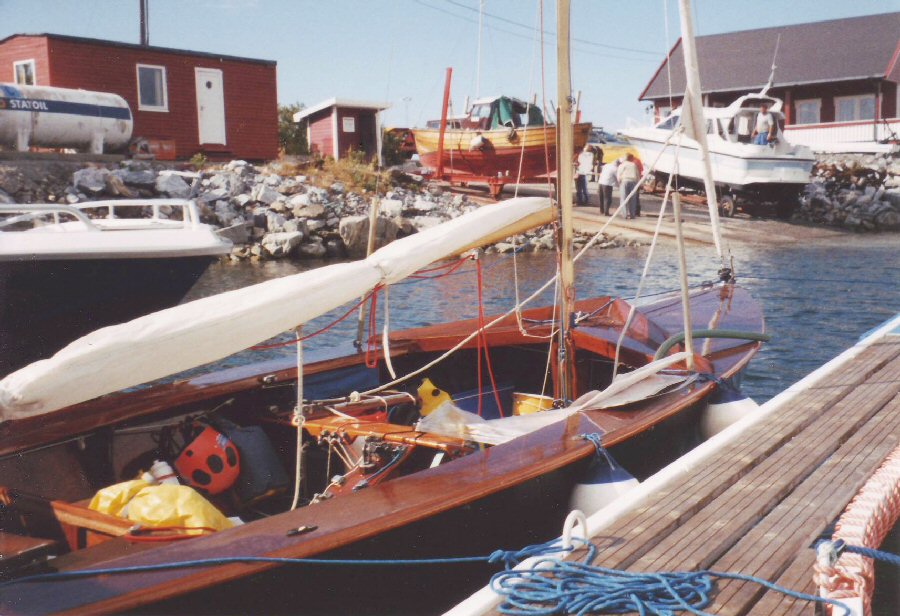 All our gear stowed
immediately prior to
our departure. The red and black crash hat was in fact
worn only once during the trip - on our only day’s sailing into a strong headwind. 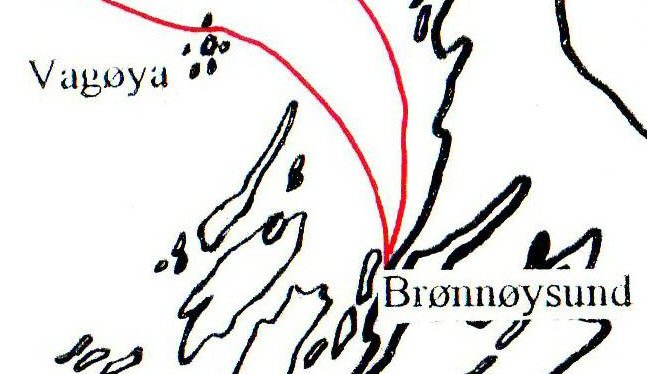 It was gone 1830 by the
time we had packed the
boat for our two-week cruise, which would have been far too late to set
off on
any trip in the UK. But with nearly 24 hours of daylight this near the
Arctic
Circle, we were able to set sail to the Vagøya group of islands,
where we were planning to camp for the night. There
was a good breeze and bright sunshine, so we enjoyed a pleasant
five-mile
beat to a
suitably sheltered bay on the second of the islands we approached.
Landing at
nearly 2000, close to low water, we anchored the boat bow and aft.
Extra care being
taken at this stage not to make the first mark on the perfect finish of
the
boat, either inside and out.
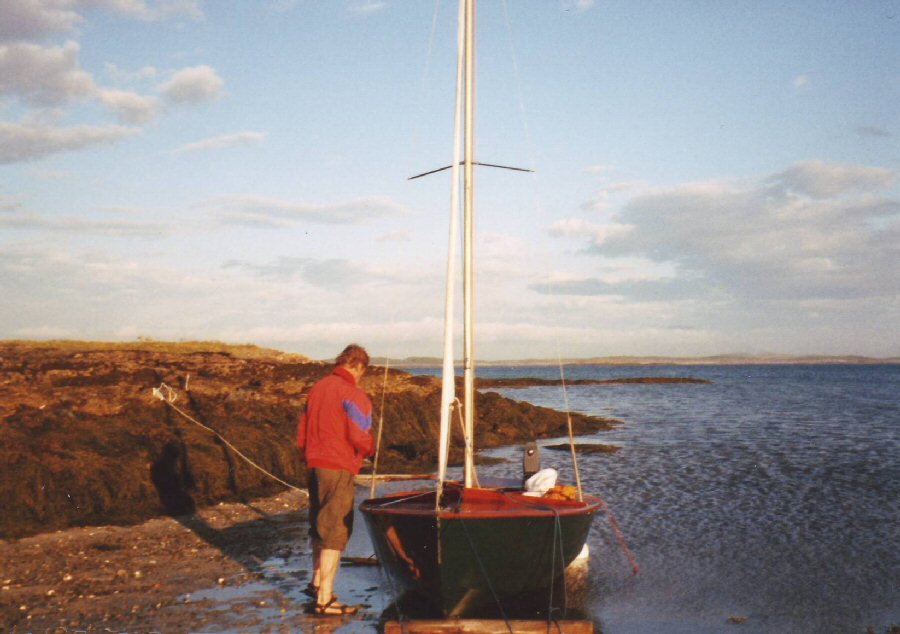 Wilhelm considers
whether his newly
painted and varnished boat will be secure. It is near to low tide,
and he is concerned that the sharp stones and shells up to the high water mark could puncture the inflatable rollers. A
grassy area slightly sheltered by a bank and well above the high water
mark
made a good place to pitch our tents. Normally it doesn’t take long for
the
local mosquito population to hunt down any juicy, fair-skinned English
quarry.
However, I had not forgotten the nuisance they had been in
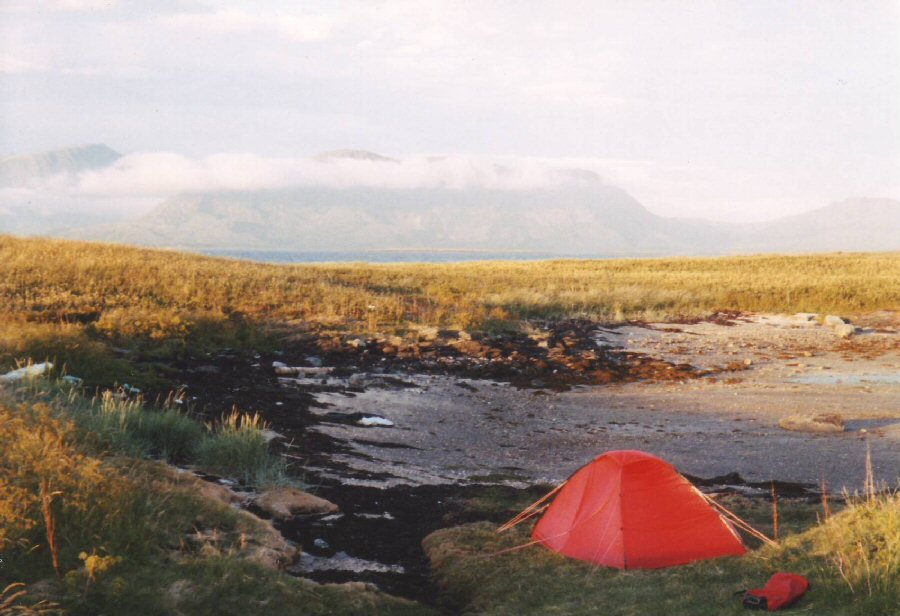 Wilhelm’s tent on a
grassy area kept well
shorn by wild sheep. The position was sheltered by a bank, from which
the photo
was taken. In the background is the mountain range on the mainland,
with many
peaks above the cloud line.
|
|
Day 2: Vagøya
to Vega
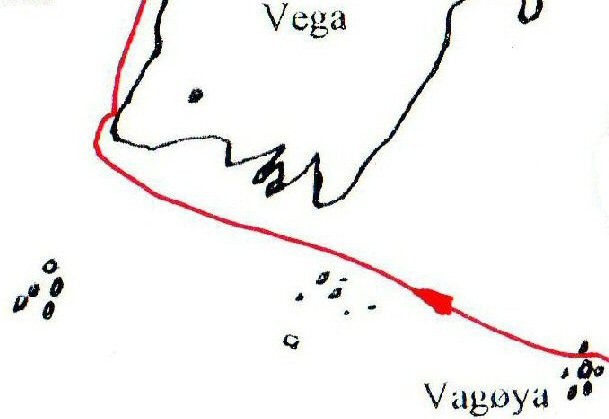 The next morning was
fine and warm, though a little
cloudy. We packed the boat rather
more efficiently than we had the
previous evening when setting off had been more important than worrying
too
much about stowage. We were away by 1130, hardly an early start
by normal
cruising standards, but we were sailing with the inclination to gain
the most
pleasure and enjoyment from the trip, rather than to try to sail as
many miles
as possible. We also had the advantage of having no particular time by
which we
had to arrive at our destination before darkness.
Winds
were generally light and
variable for another five-mile sail - this one to Vega. We started and
finished by motor
sailing,
whilst enjoying a pleasant following breeze during the mid-part of the
day’s
cruise. Rounding the southwest tip of the island, we investigated the
first
cove, only for Wilhelm to decide that it would be too rocky at low
tide.
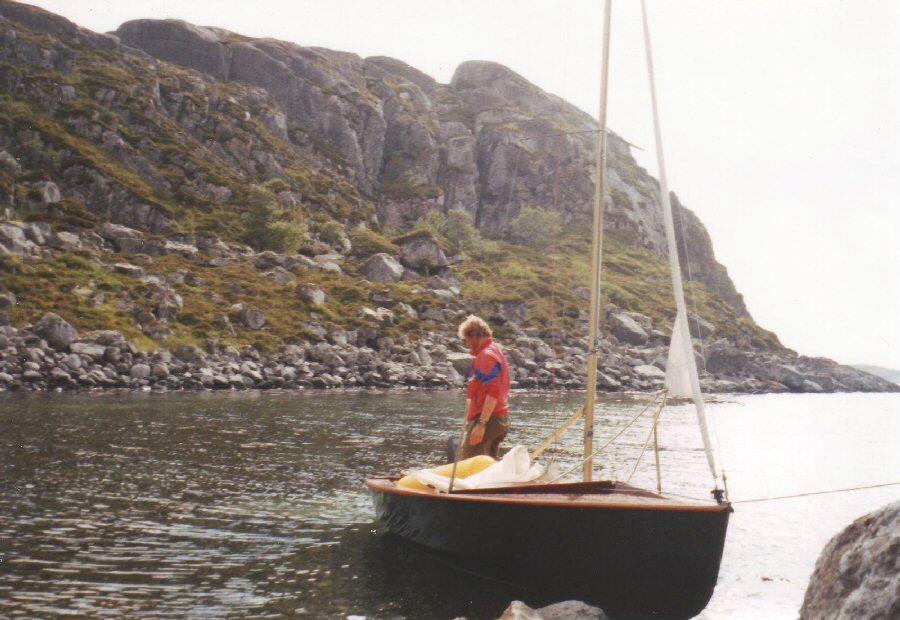 Vega landfall:
Wilhelm has dropped a
stern anchor and secured the bow to a
rock ashore.
Though the strength of the tide wasn’t as great as that around the 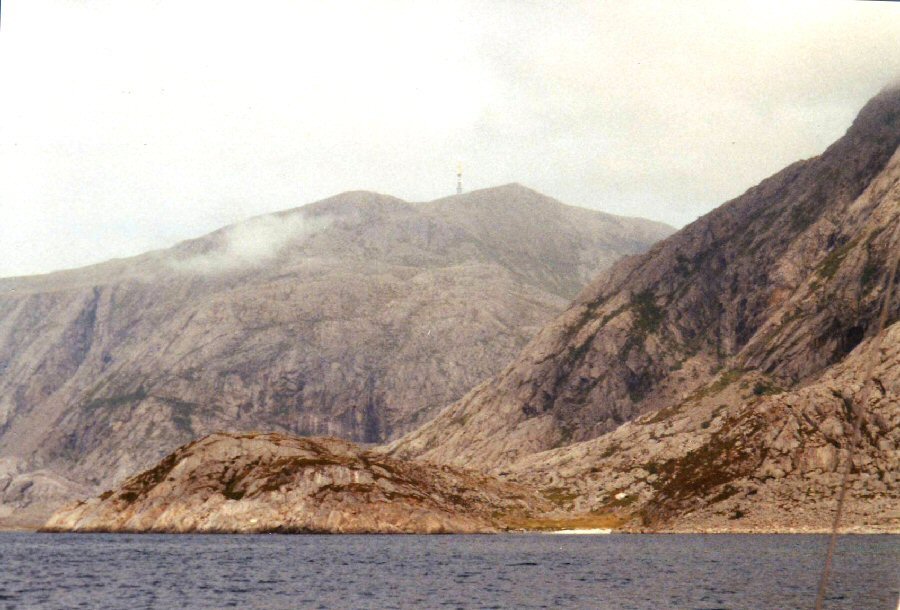 With very little
breeze in the lee of the
mountains, we motored round the next headland to find what appeared to
be a
sandy beach with a grassy area beyond, that looked ideal for camping
(to the
right of the
centre of the picture).
A
little further along the rocky shoreline at the next inlet, a welcoming
sandy
beach appeared, and we made our way into a much more suitable landing
place. We
rolled Blunderbus up to the high
water mark. Wilhelm had seen this done for the first time at the UK
Cruising
Conference the previous Spring, and had bought some inflatable rollers
especially for this trip. He was still a little surprised at how easily
only two people could perform the task. The shallow gradient made this
possible
without the need for any winch system. Rolling the boat beyond the
tide-line
removed any concerns about anchors holding, the wind
changing
direction, or the boat grounding at low tide.
... |
|
Day 3: Vega
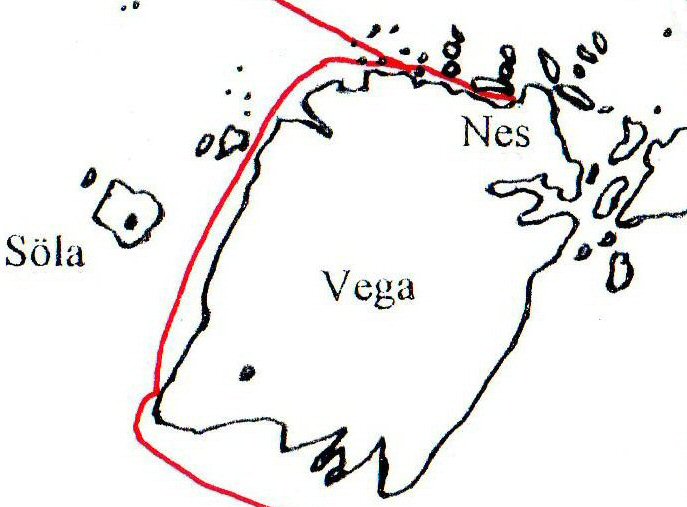 Wilhelm’s
ambition for the trip was to climb as many mountains of his very
beautiful and
wonderfully rugged country as was possible during the trip. Next
morning
therefore, we hiked off on an intermittently marked track which Wilhelm
expected to lead us to the high ridge of the mountain on the
south shore
of the island.
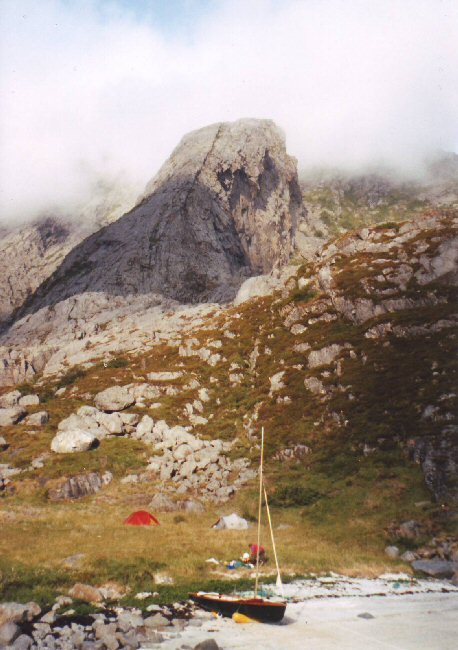
Blunderbus rolled
up to the high water
mark, with our tents pitched immediately behind.
Low cloud is obscuring the mountain Wilhelm aimed to climb. 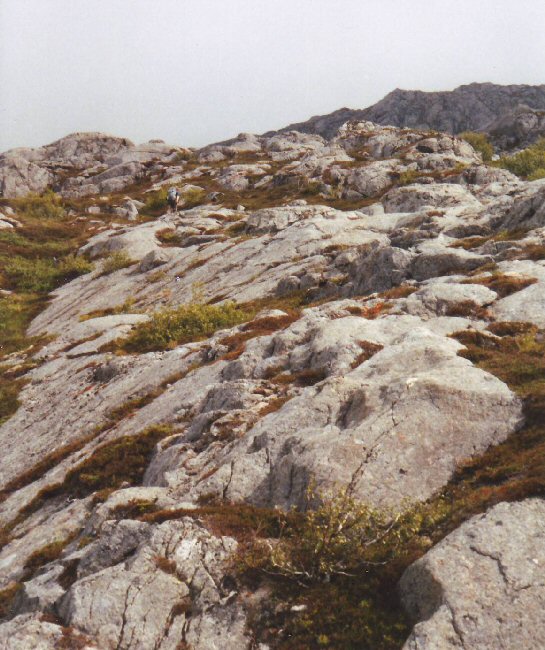 Wilhelm is barely visible, adjacent to the top of a grassy patch on the far left. The mountain peak is in the distance on the right. After a
1½ hour walk, during which we had ascended to the lower
foothills, the
track appeared
to drop back down toward the coast – a route that quite appealed to me
as I
remember, since my legs were beginning to tire from the constant
climbing.
Wilhelm
decided at this point, that it would be better to continue upwards, and
join the trail at a higher point. Feeling that I would hold Wilhelm
back if I
ventured further, I suggested he continue alone, and watched him
disappear
into the distance, like a mountain gazelle released from a cage.
I
was happy to sit and relax for a
while. Although the sky was somewhat grey and overcast, the views over
the sea
were still spectacular, with a cluster of small islands immediately
offshore,
most only a meter or two above the sea until they finally disappeared
from
view, and there was nothing but the vastness of the North Sea beyond.
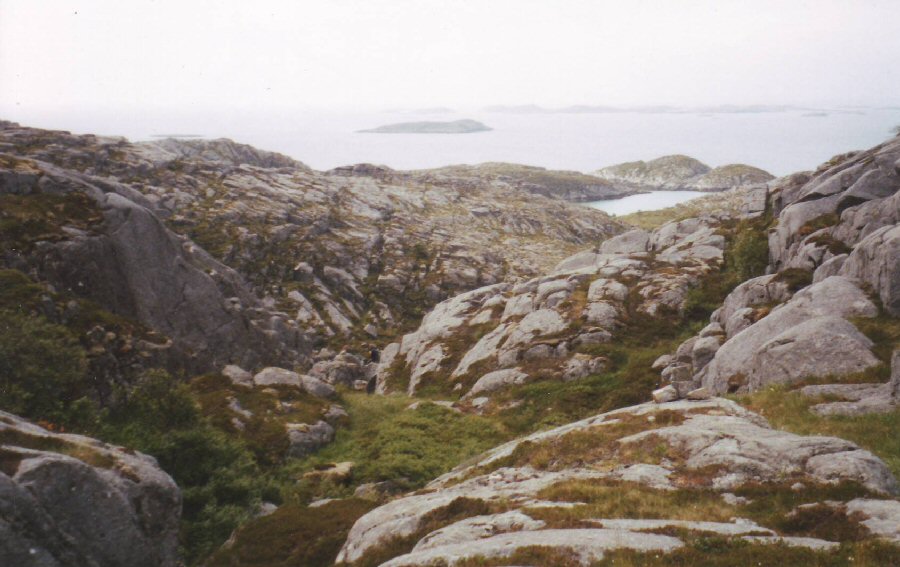
Looking out to the
The photo makes the day seem more overcast than it actually was. The group of the small islands in the far distance could easily have been mistaken for a school of whales. Having
taken my fill of the beauty and peacefulness before me, I wandered back
to our camp at a leisurely pace, stopping quite frequently to take in
the views at
the top of any vantage point, and to pick wild blueberries and the
local moltebær. These are considered
to be quite a delicacy in
Wilhelm
returned a little after 1700, just as I was beginning to wonder at what
point
I should raise the alarm for his non-return, especially as he had been
confident that he would return in time to sail to a more northerly
point on
the
island. He mentioned that he had signed a book, kept in a waterproof
metal box
at the top of each mountain, where climbers could record their success.
He had
been sorry that I had been unable to add my name, but from his
description of
the climb, I knew that I had made the right decision to stop where I
did.
I
had already packed most of the
gear, so we were able to get away by 1830. We beat our way
past the nearby
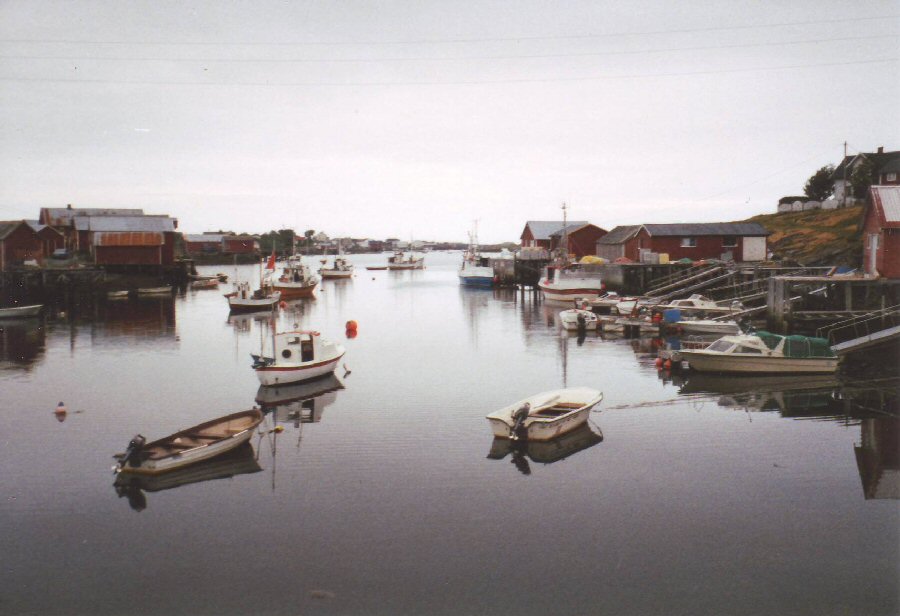 Nes. The
Wayfarer is tied up to a jetty just beyond the row of fishing sheds on
the
left.
of the naturally sheltered harbours we visited, and the whole area was well used, mostly by fishing vessels. 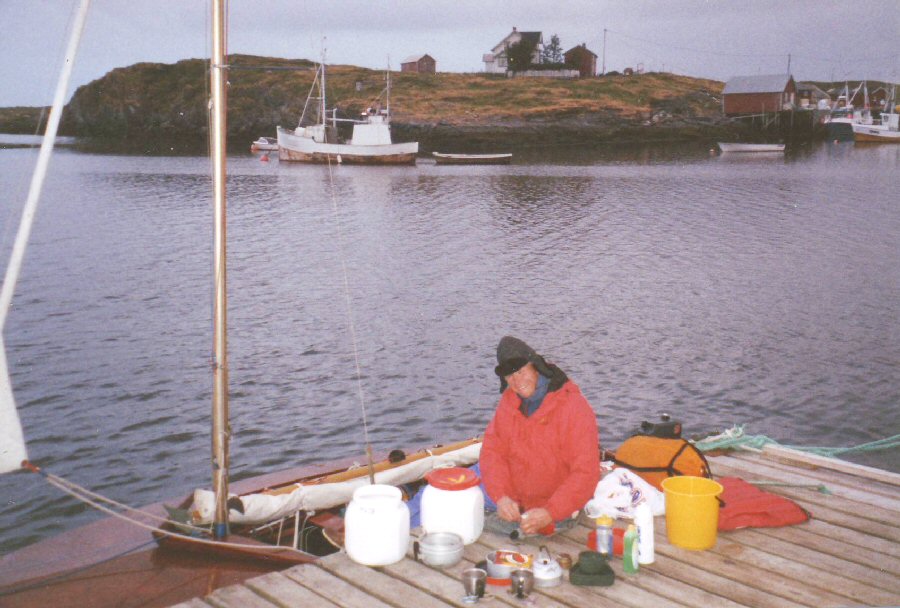 Even at 2330, there was still plenty of natural light to work by. In
Nes, we
were welcomed with a warmth that
I have experienced many times on sailing into a small harbour, where
seafaring
folk appreciate the seamanship required by small open-boat sailing, and
we were
told it
would be no problem to pitch our tents on a nearby grassy area. It was
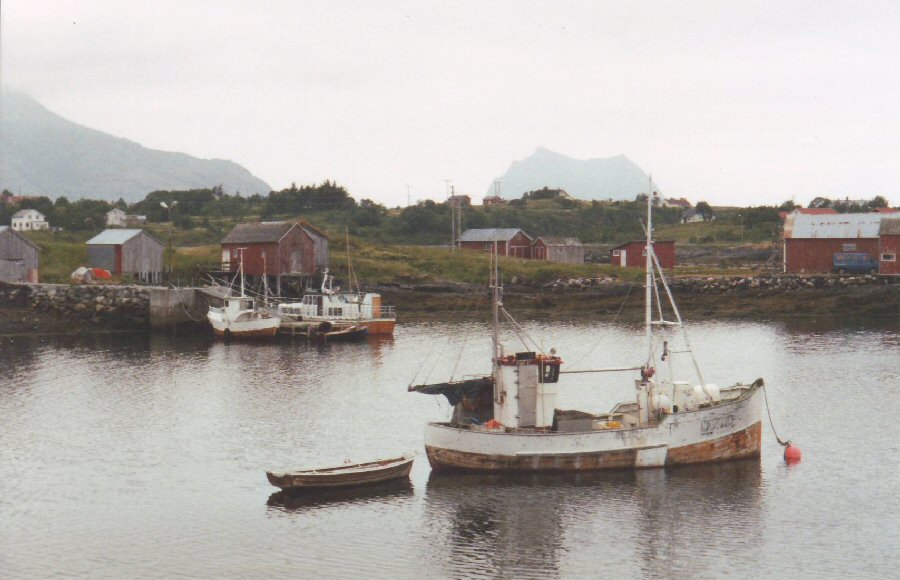 Blunderbus is tied
up
to jetty on far side
of the water with Wilhelm’s red tent just visible against a shed on far
left.
...Above the moored fishing boat you can just see the crumbling peaks of the mountain on the small |
|
Day 4: Vega to
Hysvær
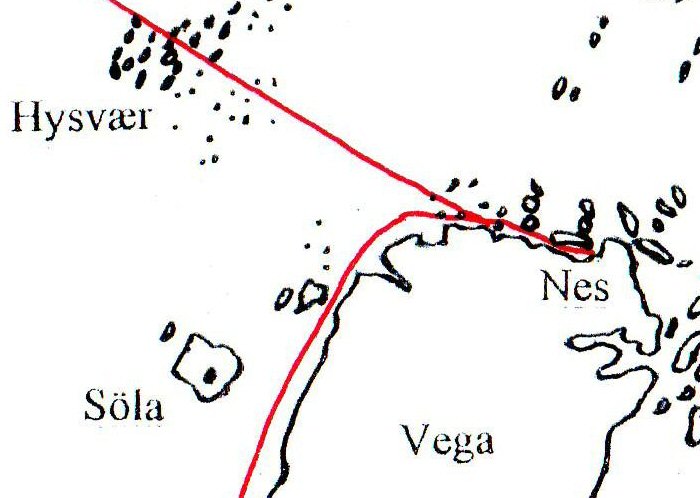 We
made a late start the next day, not setting
out until past 1500. A leisurely morning
stroll around the
immediate
area included a visit to the local shop to
replenish
our food stocks. Winds were very light when we set off, but Wilhelm was
determined
to maintain his sailing reputation with the local fishermen, and
patiently
tacked
his way out of the harbour entrance. We did, however, need to resort to
the motor
whilst weaving our way through the islands beyond, as these tended to
block what
little wind there was.
Once into more open water, we had an
easy sail to Hysvær, a group of over 50 small islands, a few of
which are
permanently inhabited. Wilhelm spotted a floating pontoon as we
approached one
of two islands with obvious signs of habitation. His
unusual (for me anyway) bigger boat
technique
always came to the fore whenever we approached any jetty: He
asked for the
fenders to
be put out. Every dinghy
sailor I
know always sails straight up to any landing place, and only sorts out
the
fenders and rope to tie up once berthed. I have to admit that
Wilhelm’s
approach was the more seamanlike though.
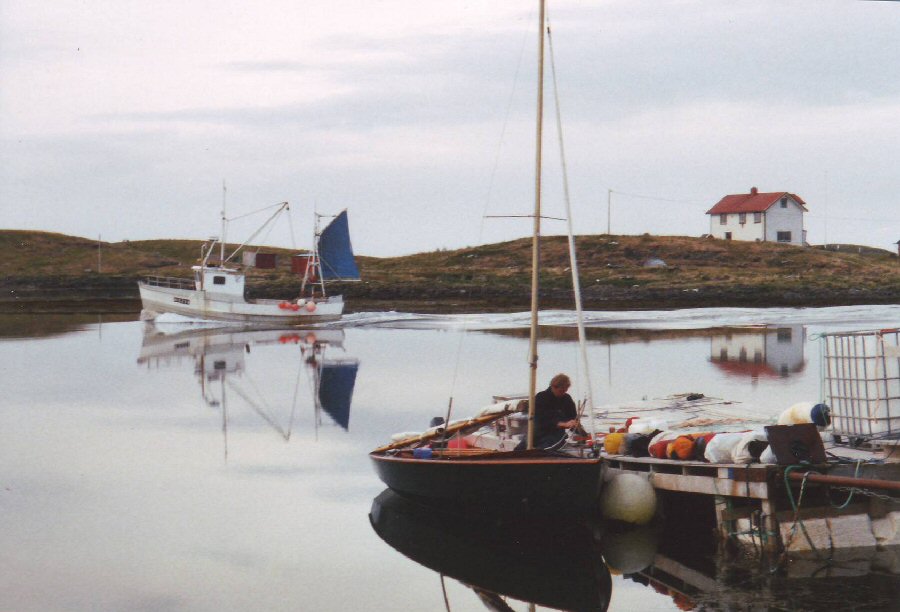 Hysvær.
All the gear
which has been unpacked from the front locker has been placed in a line
along
the edge of the jetty, with the hatch lid at the front, resting on the
first
item. Wilhelm was quite amazed at how much I was able to pack into this
space!
As
luck would have it, we happened
to land at a pontoon belonging to Øystestein Ludvigen who had
been the subject
of a Norwegian TV series entitled A
year in the Life, which showed the
variety of things he did to make a living on the island. These included
fishing,
keeping wild sheep, and collecting eider duck down. Wilhelm had already
explained to me how Øystestein had been very enterprising, using
his ingenuity
and many reclaimed materials to build a restaurant and a small heated
open-air
bathing pool.
Walking up over the brow of a hill along a short
grassy path, we came to his house where
Øystestein was on the roof with a high-pressure hose, cleaning
lichen off the
roof so that the rainwater collected could be used for drinking
purposes.
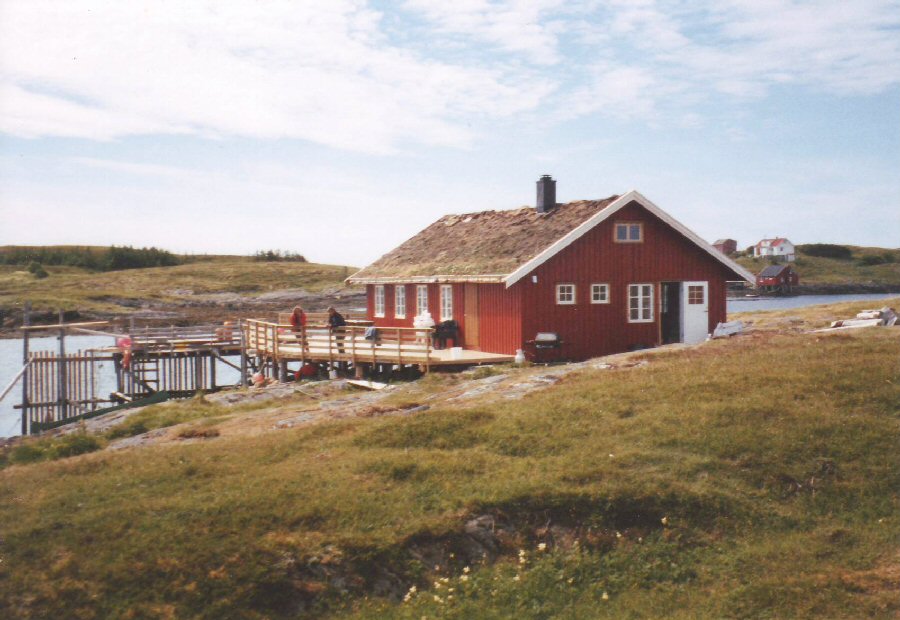 Wilhelm
talks to Snoøfridd on the
decking outside the newly built restaurant. Much of the platform was
made up
from pieces of timber washed up on the shores of the islands, some of the supporting sections being quite massive. Both Øystestein and his wife,
Snoøfridd, though seemingly always busy, were happy to entertain
Wilhelm and me
with stories of their life on the island. Whilst I was unable to
understand anything being said, I could immediately recognise the
energy of a
person who was obviously so at home in his environment. I looked around
the
very impressive restaurant he had built to cater to the various
visitors who now came to the island. Though it
was difficult
to see how regular visitors would arrive in any great number, as
there is no regular
ferry. Not that
catering for
any group was ever going to be easy, with no running fresh water or
mains
electricity. But Øystestein just seemed to look on any such
difficulties as
mere challenges to be overcome by one means or another.
Øystestein and Snoøfridd invited us
to share a simple meal with them, after which they
promised
to take us out in their 6-meter aluminium motor boat to show us the
natural
beauty
of the area. Øystestein finally stopped working at nearly 2200,
after
which we all retreated to the restaurant for a drink. The restaurant
had
apparently been open for the past three months. The
eating
area was indeed nicely finished and very tastefully fitted out in a sea
fishing
theme, with
nets draped from the wooden rafters. However, with no running water in
the
washrooms, and with the kitchen still being fitted out, it was just as
well
they didn’t have to satisfy any of the normal catering regulations –
not that any visitors would particularly concern themselves
with
such things. The hospitality and the excellent ‘home cooking’ on offer
could
not be surpassed.
Øystestein
and Wilhelm chatted for some time, and it was nearly
It
was 0100 before I finally climbed into bed that night, grateful that
Snoøfridd
had offered me a dormitory bunk to sleep in – which proved rather more
comfortable
than my camp bed on the boat!
... |
| Part 2 return to this log's index |